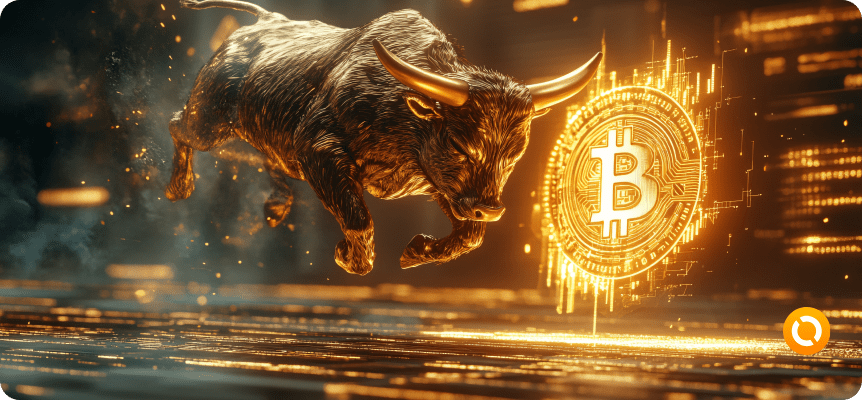Unlike them, Bitcoin is not backed by precious metals or physical assets. This is what causes skepticism about the first cryptocurrency, which some call a “bubble”.
Bitcoin is “mined” through mining, a process of creating new coins using computing power. At first glance, it seems like the asset is simply “created out of thin air,” but its value is formed due to limited supply, high demand, and unique blockchain technology. So what makes Bitcoin the leader of the cryptocurrency market and what supports its rate?

Bitcoin Opinions and Debates
Bitcoin has been around for over 13 years, but even today opinions are divided. Some see it as the future of the financial system, while others see it as a risky investment. Skeptics often argue that the cryptocurrency’s decentralization makes it similar to a Ponzi scheme. They believe that early investors have made huge profits, while those who invest now will have to settle for lower returns.
However, this view ignores key facts. First, Bitcoin has become an asset that large public companies and institutional funds invest in. Second, there is a billion-dollar infrastructure built around it, employing thousands of specialists around the world.
A Scientific Look at Bitcoin
In 2018, Yale University economists Yukun Liu and Oleg Tsyvinsky conducted a study called “Risks and Returns of Cryptocurrency.” One of the conclusions of their work was an assessment of the probability that the value of Bitcoin will ever fall to zero. According to their calculations, this risk is from 0% to 1.3%.
It is worth noting that this study was conducted when Bitcoin cost about $7,000. Today, its price is much higher, and the asset has attracted the attention of large investors. Thanks to the growth of trust from corporations and further development of technology, the probability of the collapse of the cryptocurrency looks minimal.
What is Bitcoin backed by?
Bitcoin’s main source of support is its unique blockchain technology and its ever-growing user community.
Development Team. The cryptocurrency is backed by a group of enthusiasts who are constantly working to improve the network: increasing transaction speeds, reducing fees, and improving security.
Decentralization. The Bitcoin system is designed so that every transaction is recorded in a secure database that all participants have access to. This eliminates the need for intermediaries such as banks and ensures user privacy.
Miners. Network participants invest heavily in equipment and electricity to ensure the stability of the system. Their costs reflect the underlying cost of mining coins and help maintain the value of the asset.
The structural value of Bitcoin
Bitcoin is unique in that its value is not derived from physical assets, but from the technology itself. The blockchain network ensures transparency and security of transactions, while users retain full control over their assets.
This can be compared to the Internet: although it has no physical backing, its usefulness and scale of use make it an integral part of the modern world.
The role of mining
Miners play a key role in maintaining the stability of the network. They invest significant amounts of money in equipment and electricity to mine new coins. These investments create the base level of Bitcoin’s value.
However, it is incorrect to consider mining costs as the only source of value. As with sand mining from the seabed, the cost of production does not guarantee that the asset will find a buyer. However, high interest from users and investors supports the cryptocurrency’s price.
Can Bitcoin Depreciate?
For the price of Bitcoin to fall to zero, it would be necessary to destroy the entire infrastructure associated with it, which covers millions of users and billions of dollars of investment.
Today, Bitcoin is not just a cryptocurrency, but an entire ecosystem that includes large companies, crypto exchanges, mining farms, and millions of investors around the world. For Bitcoin to lose its value, it would have to become completely unnecessary for users, which seems almost impossible in today’s conditions. Moreover, the demand for Bitcoin is likely to persist not only in the coming decades, but also for centuries.
Why Bitcoin Is Not in Danger of Devaluation?
Despite the skepticism, Bitcoin has a number of factors that protect it from complete devaluation. Let’s look at the key reasons why the price of this cryptocurrency will not only not fall to zero, but will continue to grow in the long term.
- Limited emission
Bitcoin is designed to grow in value. The maximum number of bitcoins is limited to 21 million coins, and about 90% of them have already been mined. At the same time, millions of coins are lost forever, which makes the remaining bitcoins even more valuable. Even after the last coin is mined, the demand for this asset will most likely remain high, which will support its price. - High mining costs
Bitcoin mining is an energy-intensive and expensive process. Miners invest in equipment, electricity, and infrastructure, which forms the base cost of each coin. The higher the mining costs, the higher the minimum price at which miners are willing to sell their bitcoins. - Decentralization
Bitcoin is a completely decentralized system that is resistant to hacking and manipulation. No one controls the issuance of coins, and the entire network is protected by complex cryptography. This unique advantage makes the cryptocurrency attractive to users around the world. - Support of large players
The so-called “bitcoin whales” – large investors who have invested billions of dollars in BTC – are not interested in the asset falling. Their actions in the market stabilize the price and minimize the likelihood of significant depreciation. - Growing adoption in the economy
Every year, bitcoin is becoming more and more integrated into the real economy. It is used for international transfers, online shopping, and even as a means of accumulating capital. The more people and companies start using cryptocurrency, the higher its value. - Alistair Milne’s guarantee
The famous investor and entrepreneur Alistair Milne once said that he was ready to buy out all the bitcoins if its price fell to $0.01. In 2020, he placed an order to buy 18.52 million BTC on the Bitfinex exchange, thereby publicly declaring that Bitcoin could not be completely devalued.
Conclusion
Although Bitcoin is not backed by traditional assets such as gold or oil, its value lies in its unique technology and growing user trust. It offers financial freedom, decentralization, and secure transactions.
In addition, Bitcoin is becoming more and more established in the real economy every year, becoming an integral part of the global financial sector. Even if its price temporarily decreases, the demand for the asset and its unique properties will ensure further growth.
Thus, Bitcoin remains one of the most promising and depreciation-proof cryptocurrencies in the world.
Over time, Bitcoin continues to evolve, attracting the attention of investors and introducing innovations. All this makes it an important element of the digital economy and strengthens its position as a leader in the cryptocurrency market.











